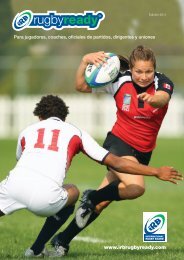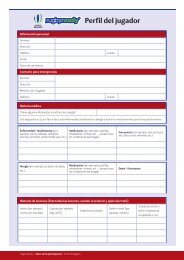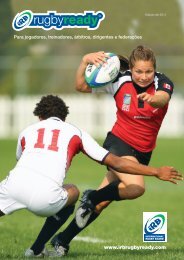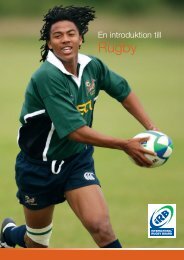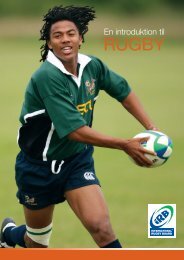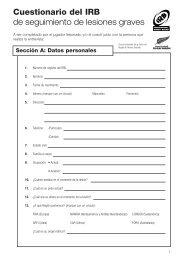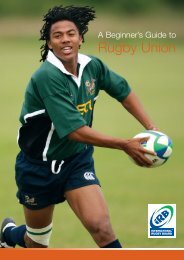IRB Beginner's Guide to Rugby - IRB Rugby Ready
IRB Beginner's Guide to Rugby - IRB Rugby Ready
IRB Beginner's Guide to Rugby - IRB Rugby Ready
Create successful ePaper yourself
Turn your PDF publications into a flip-book with our unique Google optimized e-Paper software.
The <strong>IRB</strong>’s definition of injury<br />
“Any physical complaint, which was caused by a transfer of energy that exceeded the body’s ability <strong>to</strong> maintain its structural<br />
and/or functional integrity, that was sustained by a player during a <strong>Rugby</strong> match or <strong>Rugby</strong> training, irrespective of the need<br />
for medical attention or time loss from <strong>Rugby</strong> activities. An injury that results in a player receiving medical attention is<br />
referred <strong>to</strong> as a ‘medical attention’ injury and injury that results in a player being unable <strong>to</strong> take a full part in future <strong>Rugby</strong><br />
training or match play as a ‘time-loss’ injury.”<br />
Testing a player for the symp<strong>to</strong>ms of concussion<br />
The Sport Concussion Assessment Tool 2 (SCAT2)*, the text of which in abbreviated form (Pocket SCAT2) is set<br />
out below, is approved by the Fédération Internationale de Football Association (FIFA), its independent research<br />
body F-MARC (FIFA-Medical Assessment and Research Centre), the International Ice Hockey Federation (IIHF), the<br />
International Olympic Committee (IOC) and the International <strong>Rugby</strong> Board itself.<br />
Pocket SCAT2<br />
Concussion should be suspected in the presence of any<br />
one or more of the following: symp<strong>to</strong>ms (such as headache),<br />
or physical signs (such as unsteadiness), or impaired<br />
brain function (e.g. confusion) or abnormal behaviour.<br />
1. Symp<strong>to</strong>ms<br />
Presence of any of the following signs & symp<strong>to</strong>ms may<br />
suggest a concussion.<br />
• Loss of consciousness<br />
• Seizure or convulsion<br />
• Amnesia<br />
• Headache<br />
• “Pressure in head”<br />
• Neck Pain<br />
• Nausea or vomiting<br />
• Dizziness<br />
• Blurred vision<br />
• Balance problems<br />
• Sensitivity <strong>to</strong> light<br />
• Sensitivity <strong>to</strong> noise<br />
• Feeling slowed down<br />
• Feeling like “in a fog“<br />
• “Don’t feel right”<br />
• Difficulty concentrating<br />
• Difficulty remembering<br />
• Fatigue or low energy<br />
• Confusion<br />
• Drowsiness<br />
• More emotional<br />
• Irritability<br />
• Sadness<br />
• Nervous or anxious<br />
2. Memory function<br />
Failure <strong>to</strong> answer all questions correctly may suggest a concussion.<br />
“At what venue are we at <strong>to</strong>day?”<br />
“Which half is it now?”<br />
“Who scored last in this game?”<br />
“What team did you play last week / game?”<br />
“Did your team win the last game?”<br />
3. Balance testing<br />
Instructions for tandem stance<br />
“Now stand heel-<strong>to</strong>-<strong>to</strong>e with your non-dominant foot<br />
in back. Your weight should be evenly distributed<br />
across both feet. You should try <strong>to</strong> maintain stability<br />
for 20 seconds with your hands on your hips and your<br />
eyes closed. I will be counting the number of times<br />
you move out of this position. If you stumble out of<br />
this position, open your eyes and return <strong>to</strong> the start<br />
position and continue balancing. I will start timing<br />
when you are set and have closed your eyes.”<br />
Observe the athlete for 20 seconds. If they make more than 5 errors<br />
(such as lift their hands off their hips; open their eyes; lift their forefoot<br />
or heel; step, stumble, or fall; or remain out of the start position for<br />
more that 5 seconds) then this may suggest a concussion.<br />
Any athlete with a suspected concussion should<br />
be IMMEDIATELY REMOVED FROM PLAY, urgently<br />
assessed medically, should not be left alone and<br />
should not drive a mo<strong>to</strong>r vehicle.<br />
* Developed by a group of international experts at the 3rd International Consensus meeting on Concussion in Sport held in Zurich, Switzerland in November<br />
2008. The full details of the conference outcomes and the authors of the <strong>to</strong>ol are published in British Journal of Sports Medicine, 2009, volume 43,<br />
supplement 1.<br />
Disclaimer The injury management information provided in this <strong>IRB</strong> <strong>Rugby</strong> <strong>Ready</strong> product is intended as a <strong>to</strong>ol <strong>to</strong> assist in the care and<br />
management of injured players. It does not displace the benefit of having suitably qualified personnel available <strong>to</strong> treat injuries. The <strong>IRB</strong> (including<br />
its operating entity IRFB Services (Ireland) Limited and other associated entities) does not accept any responsibility or liability in negligence or<br />
otherwise relation <strong>to</strong> the treatment, care or management of injured players.<br />
www.irbrugbyready.com<br />
<strong>IRB</strong> <strong>Rugby</strong> <strong>Ready</strong> / Injury management<br />
55



